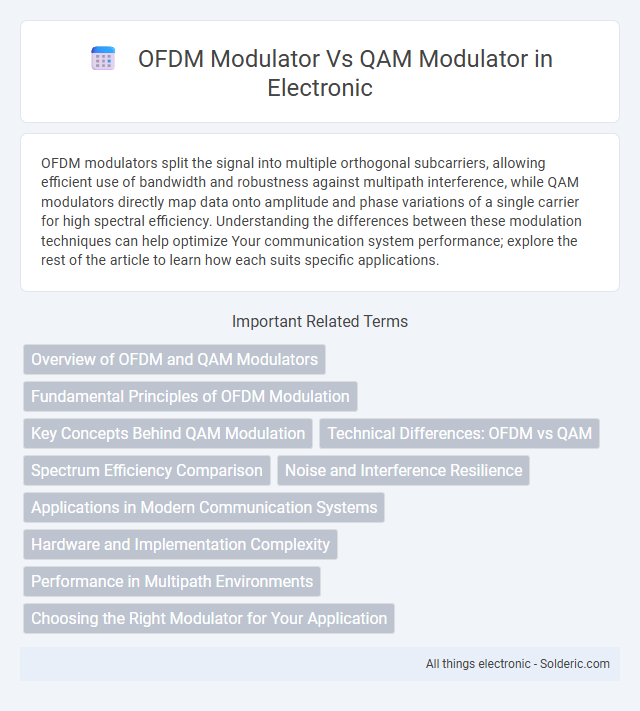OFDM modulators split the signal into multiple orthogonal subcarriers, allowing efficient use of bandwidth and robustness against multipath interference, while QAM modulators directly map data onto amplitude and phase variations of a single carrier for high spectral efficiency. Understanding the differences between these modulation techniques can help optimize Your communication system performance; explore the rest of the article to learn how each suits specific applications.
Comparison Table
| Feature | OFDM Modulator | QAM Modulator |
|---|---|---|
| Modulation Type | Multicarrier modulation | Single-carrier amplitude and phase modulation |
| Data Transmission | Parallel data streams on multiple subcarriers | Serial data stream on a single carrier |
| Resistance to Multipath Fading | High resistance due to orthogonal subcarriers | Lower resistance without equalization |
| Bandwidth Efficiency | High spectral efficiency with overlapping subcarriers | Moderate, depends on constellation size |
| Complexity | Higher (requires FFT/IFFT processing) | Lower complexity |
| Use Case | Wi-Fi (IEEE 802.11), LTE, DVB-T | Modems, digital TV, radio links |
Overview of OFDM and QAM Modulators
OFDM modulators divide a high data rate signal into multiple lower-rate subcarriers, each modulated using QAM or other schemes, enhancing resistance to multipath fading and improving spectral efficiency in wireless communications. QAM modulators directly map digital data into amplitude and phase variations on a single carrier, supporting high data rates but with less robustness to channel impairments compared to OFDM. Your choice between OFDM and QAM modulators depends on system requirements such as bandwidth efficiency, channel conditions, and complexity constraints.
Fundamental Principles of OFDM Modulation
OFDM modulation divides a high-rate data stream into multiple lower-rate streams transmitted simultaneously over orthogonal subcarriers, minimizing inter-symbol interference and improving spectral efficiency. Unlike QAM modulation, which encodes data on amplitude and phase of a single carrier, OFDM leverages fast Fourier transform (FFT) algorithms to efficiently generate and demodulate signals across these subcarriers. Your communication system benefits from OFDM's robustness in multipath environments, making it ideal for broadband wireless applications.
Key Concepts Behind QAM Modulation
QAM modulation encodes data by varying both the amplitude and phase of a carrier signal, enabling efficient use of bandwidth with multiple bits per symbol. This technique combines two amplitude-modulated signals into a single channel, maximizing data throughput in communication systems. Your choice between OFDM and QAM modulators depends on system requirements, as QAM primarily focuses on symbol mapping while OFDM manages frequency division multiplexing for multi-path resistance.
Technical Differences: OFDM vs QAM
OFDM modulator utilizes multiple orthogonal subcarriers to transmit data in parallel, providing robustness against multipath fading and inter-symbol interference, while QAM modulator encodes data by varying the amplitude and phase of a single carrier signal, offering higher spectral efficiency in flat-fading channels. OFDM splits the bandwidth into narrowband subchannels modulated by QAM symbols, enabling efficient frequency division multiplexing. Your communication system's performance depends on choosing OFDM for multipath environments and QAM for maximizing data rate in simpler channel conditions.
Spectrum Efficiency Comparison
OFDM modulators achieve higher spectrum efficiency by dividing the available bandwidth into multiple orthogonal subcarriers, allowing simultaneous transmission of data without interference. QAM modulators transmit data on a single carrier by varying amplitude and phase, which limits their ability to fully utilize spectrum in multipath environments. Your communication system benefits from OFDM's robustness and improved spectral efficiency, especially in wireless channels with frequency-selective fading.
Noise and Interference Resilience
OFDM modulators offer superior noise and interference resilience by dividing the signal into multiple orthogonal subcarriers, reducing the impact of frequency-selective fading and inter-symbol interference. QAM modulators, while efficient in bandwidth usage, are more susceptible to noise and nonlinear interference due to their dense constellation points. The inherent orthogonality and multi-carrier nature of OFDM significantly improve signal robustness in multipath and noisy environments compared to single-carrier QAM modulation.
Applications in Modern Communication Systems
OFDM modulators are widely used in modern communication systems such as 4G LTE, 5G NR, and Wi-Fi 6 due to their robustness against multipath fading and high spectral efficiency in broadband wireless environments. QAM modulators serve as fundamental modulation schemes within OFDM subcarriers, enabling high data rate transmission in cable TV, DSL, and satellite communications by efficiently encoding multiple bits per symbol. The integration of QAM within OFDM frameworks enhances overall system capacity and reliability in diverse wireless and wired communication applications.
Hardware and Implementation Complexity
OFDM modulators require complex hardware for parallel processing and FFT/IFFT operations, increasing implementation complexity compared to QAM modulators, which use simpler, single-carrier hardware designs focusing on amplitude and phase modulation. The need for cyclic prefix insertion and sophisticated synchronization in OFDM further elevates hardware demands. Your choice depends on balancing OFDM's robustness in multipath channels against QAM's lower hardware complexity.
Performance in Multipath Environments
OFDM modulators excel in multipath environments by dividing the signal into multiple orthogonal subcarriers, reducing inter-symbol interference and improving robustness to delay spread. QAM modulators, while efficient in spectral usage, are more susceptible to fading and inter-symbol interference caused by multipath without additional equalization techniques. Your communication system benefits from OFDM's inherent resilience in complex multipath scenarios, making it ideal for wireless channels with significant reflections.
Choosing the Right Modulator for Your Application
Choosing the right modulator for your application depends on factors like bandwidth efficiency and channel conditions, where OFDM modulator excels in handling multipath interference and frequency-selective fading by dividing the data into multiple orthogonal subcarriers. QAM modulator, on the other hand, offers high spectral efficiency through varying amplitude and phase combinations, making it suitable for channels with minimal interference. Your choice between OFDM and QAM modulators should prioritize system robustness and data rate requirements.
OFDM modulator vs QAM modulator Infographic

 solderic.com
solderic.com